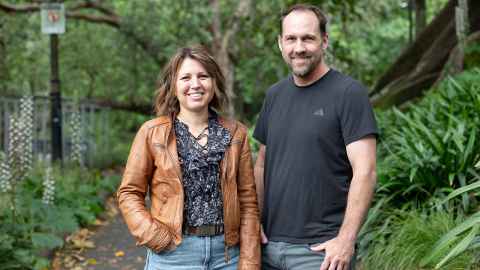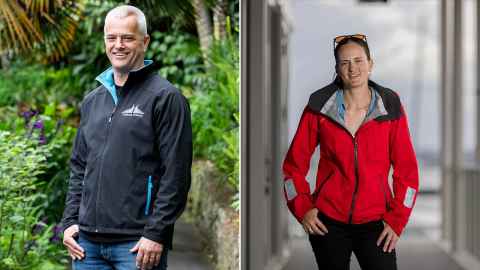A deep commitment to restoring the natural world
18 April 2024
For 25 years Dr George Mason ONZM has been one of the University’s most loyal and generous supporters. For those who have benefitted, his support has often been life-changing.

Seven scholarships in biological sciences. Ten Puke Ariki postgraduate scholarships for research on the natural environment in the Taranaki region. Four exchange scholarships between UC Davis and the University of Auckland. Fourteen scholarships in marine science.
And then in 2016, a $5 million donation to establish the George Mason Centre for the Environment, a multidisciplinary research centre, based in the Faculty of Science, which to date has funded 21 projects focused on environmental restoration, conservation and sustainability and supported 12 postdoctoral researchers and five PhD students.
For 25 years Dr George Mason ONZM has been one of the University’s most loyal and generous supporters. For those who have benefitted, his support has often been life-changing.
“Huge,” says Dr Jenny Hillman of the impact. “I wouldn’t be here without him.”
From receiving the first exchange scholarship to UC Davis in 2015 to her recent appointment to the new Hilltops to Oceans Lectureship in Marine Restoration Ecology, George Mason’s financial support has intersected with the arc of her career.
What began with private funding to work on returning green-lipped mussels to the Mahurangiarea opened out into other areas of the Hauraki Gulf. In her new role, the shellfish restoration group she leads is also working at the top of the South Island, and she collaborates with international groups involved in shellfish loss and restoration. She is now starting to look at other shellfish species that are under threat.
It’s an example of support that helps build scientific leadership, developing talented scientists undertaking research to reverse ecological damage in Aotearoa New Zealand. Not just damage inflicted in the past but in the future, including the effects of changes in the climate.
Professor Kevin Simon’s initial funding through the George Mason Centre was to research an environmental problem that, while historical in origin, has grown over time and is likely to continue increasing. The funding supported a PhD student, Nadia Dikareva, who was investigating plastic pollution in river and stream networks to try and understand where microplastic is found, why it’s found in those places and how it moves through them. The work helped elicit further funding for a large project focused on microplastics that involved researchers from institutions across Aotearoa New Zealand.
Plastic pollution is a complex problem. Research showed that the distance the microplastic moves through those networks depends in part on the plastic itself, predominantly the size of it. But the biggest influence was the nature of the waterway. Most of us have streams close by, some fairly natural, some modified, some buried in pipes, like the steam that runs under Auckland city’s Queen Street. And the changes we make to streams influence how plastics move in them on the way to pollute our beaches and sea.

“One of the harder parts of the plastic story is that people really want solutions,” Kevin says, “and it’s tricky. Plastic is made from petroleum products, so built on a non-renewable resource that’s linked to climate change. We make products that are highly useful, versatile, and extremely durable, and then we throw them away. It just doesn’t make a lot of sense to do that, especially when there clearly are alternative materials that carry a lot less risk. Because plastic is so difficult to remove once it’s in the environment, the solution is to be very careful how you use it and use less of it. And if you’re going to use it, make sure you recycle it where it’s appropriate.”
Climate change is also a factor in research in Te Tai Tokerau (Northland) into a rare ecosystem. Ahipara is home to one of the largest surviving gumlands left in Aotearoa New Zealand. Gumlands are a unique habitat supporting many threatened flora and fauna only found there and embedded in a landscape that is steadily transforming, threatening their existence.
“They are poorly understood,” says Professor George Perry, who with PhD student Cameron Guy, funded by the George Mason Centre, and with local tangata whenua and DOC is leading a research project at Ahipara.
“Gumlands are often seen as sort of scrubby waste. They form on soils where there was once kauri forest – so very low fertility, acid, very leached, and typically an iron hard pan under the soil surface, not very deep, so hard for water to get through. A special form of wetland.
“They’re a cultural nexus. Important to tangata whenua but also in the European period very important to Dalmatian people in their sense of cultural identity as workers in the gum fields.”
Gumlands were born out of fire, but their relationship is complicated: fire is needed to maintain or create them, but too much is destructive.
“We know that if they burn, they are extremely vulnerable to invasion by introduced weeds like gorse. And we also know that if we burn them, they can get in a loop where they’re more flammable, because weeds tend to be better adapted to fire. There are very few gumlands that are intact, that haven’t suffered weed invasion, or where people have broken the hard pan, wanting to change them into an agricultural setting, which completely alters the hydrology. One of the concerns is that under climate change there’ll be less rain and it might change some of that dynamic."
Also placing some urgency on the gumlands research is the move of Māori back to their land and the clearing of areas ready for papa kāinga (housing). There are important questions to be addressed, together with local communities, about how to do that safely and in a resilient way in an area that is quite fire prone. George sees the project as a pilot for modelling how to do this kind of work in the future.
“I think there’s an impetus to do more ‘useful’ work. And clearly in the environment, conservation, ecology space, that’s going to involve working with people. And I think a lot of students now want to do that. They can see that’s the way the world is.”
It’s a sentiment echoed by Associate Professor Brendon Dunphy who has changed from tracking the indicators and effects of climate change on mussels to the impact on seabirds and in particular sooty shearwater chicks. He only half-jokingly claims the switch was based on what he calls “the party test”. When people asked what he did, and he said he researched mussels “they quickly shuffle off and get another drink”.
“But if you tell them about the sooty shearwater that’s diving to 90 metres underwater, flying 60,000 kilometres every year, people are more prepared to listen, and to listen to stories about climate change if you use seabirds as your storytelling. People can be really inspired by them.”
New Zealand is the seabird capital of the world, and we have the highest percentage of endangered species. Brendon and his student researchers are using the seabirds and particularly the sooty shearwaters to track what is happening to their food because of increased air and water temperatures.
“We suspect their food source is moving further south or further offshore and it’s also not as energy dense, it doesn’t have a great nutritional profile the birds need to allow chicks to grow. We know in a heat wave we get up to 40 percent loss of weight in the chicks. And we worry they won’t get fat enough to grow their own feathers. They become very very low on reserves and if the marine environment isn’t in a good way to provide enough food for them, we suspect they will die out at sea.”
His team is working towards an automatic system that can map their growth. Scales placed in nests under the chicks constantly measure and send back the results through a cellphone network. He says the research the George Mason Centre is supporting has made him think in a different way.
“We’re getting a lot of PhD students and just volunteers wanting to work with us now. It’s sort of been my epiphany. It’s not just about being a scientist now. People are part of the puzzle. It’s getting the best information in front of them, but they also must be part of the solution.”
The goal is a secure future for seabirds, and he says it’s going to need a conglomerate of interested people from all sectors of society working with the scientists and the all-important postgraduate students.
“Let’s be honest,” says Brendon, “the students are the bulk of every academic’s productivity. But for me, the satisfying thing is having taught them as an undergrad, being able to get them a scholarship and just see them flourish. And then, much like the chicks themselves, get them fully fledged as a scientist and see them on their way.
“And that’s what the George Mason Centre funds allow you to do.”
Media contact
Helen Borne | Communications and Marketing Manager
Alumni Relations and Development
Email: h.borne@auckland.ac.nz